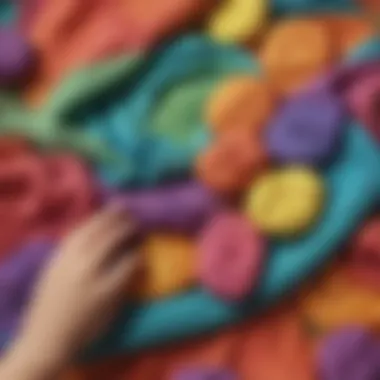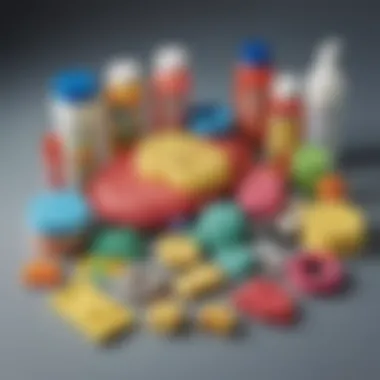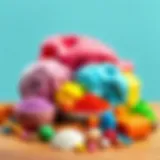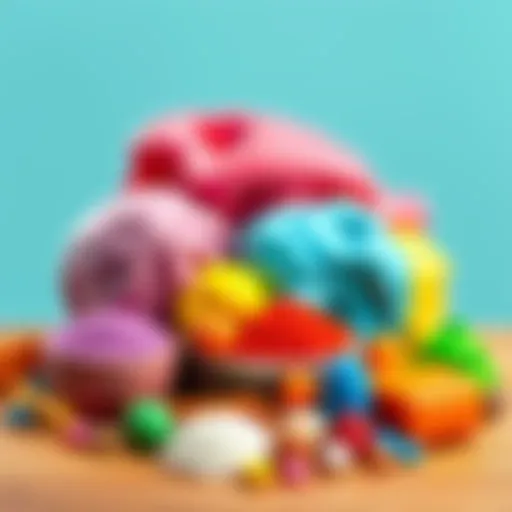Effective Techniques for Removing Play Dough from Clothing


Intro
Removing play dough from clothes is a challenge that many parents encounter. Understanding the nature of the stains and the fabric can simplify the process. With the right knowledge and techniques, it's possible to restore garments effectively. This article presents a range of practical methods tailored for might perplexed individuals faced with play dough mishaps, delving into the science and care required to maintain clothing integrity.
Science Fun Facts
Play dough is not just a favorite among children for creative play; it also comes with some interesting properties that can affect how it reacts when stuck to fabric. Here are a few facts about play dough:
- Composition: Most commercial play dough contains flour, water, salt, and the bond-forming agent, glycerin. This mix makes it soft and pliable, thus more likely to cling to clothes.
- Cleaning Challenge: The pliable nature of play dough means that it can easily embed itself in fibers, particularly in jeans or cotton shirts.
- Dried Play Dough: If allowed to dry, play dough can become hard and brittle. The texture changes significantly, making residue removal typically more complex.
Further research into cleaning methods can assist in comprehension of material types.
Identifying the Fabric
Before taking any steps to remove play dough, it's vital to determine the type of fabric in question. Different materials reactive differently to cleaning methods. For example:
- Cotton: Durable and can handle various cleaning agents.
- Wool: Sensitive; using hot water can damage fibers.
- Synthetic fabrics: Can tolerate some solvents, but a test is recommended prior treatment.
This insight can ensure an appropriate and effective cleaning method.
Methods for Removal
Here’s a list of effective techniques to remove play dough:
- Scraping the Excess: Use a dull knife or credit card to gently lift away any excess play dough without damaging the fabric.
- Freezing: For best results with dried stains, place the article in the freezer for approximately 30 minutes. After freezing, it can often be more easily scraped off.
- Warm Water Treatment: If the dough is fresh, run the fabric under warm water for a few minutes to loosen it.
- Use of a Stain Remover: Apply a small amount of stain remover. Check the fabric type to ensure the remover is safe before usage.
- Laundry Wash: After pre-treatment, wash the garment according to care instructions. Inspect the stain only after drying as heat can set the stain.
Understanding Play Dough
When addressing how to remove play dough from clothes, it becomes vital to understand the substance itself. Knowing what play dough is made of sheds light on why it adheres to fabric. This knowledge aids in formulating effective stain removal strategies.
Composition of Play Dough
Play dough is typically composed of several key ingredients. Most commercial play doughs have flour, water, salt, and various additives to enhance texture and scent. Often, food coloring is mixed in to create vibrant hues. Many brands also include preservatives to prolong shelf life. Understanding this composition helps one to realize that the starches in flour contribute to its stickiness. This stickiness is why removing play dough from clothes can be troublesome.
It is essential to recognize that variations exist among different brands and homemade versions. Homemade play dough might vary in proportions. Therefore, the efficacy of removal techniques might also change based on this composition.
How Play Dough Adheres to Fabrics
Play dough adheres to fabrics due to multiple factors. Its moisture content interacts with the tiny fibers of clothing, creating a bond that can be hard to break. The salt present in play dough further adds to this adhesion as it penetrates the fabric layers slightly. Thus, attempts to hastily scrape or remove the dough usually lead to deepening the stain rather than eliminating it.
Additionally, different fabric types react differently with play dough. For example, smoother fabrics like polyester may allow easier removal compared to rougher textiles such as cotton. This understanding enables one to tailor removal methods appropriately, minimizing potential damage to fabric while effectively addressing the stain.
Understanding the nature of play dough not only aids cleaning efforts but also contributes to effective long-term maintenance of garments. Uninformed approaches may lead to damage or an even tougher stain.
Initial Steps for Stain Removal
Removing play dough from clothing can be a challenging task. Initial steps are key in this cleaning process. Understanding how to approach the stain properly not only helps in the effectiveness of removal but also protects the fabric’s integrity. Neglecting these initial actions might lead to a more formidable stain that requires extensive cleaning efforts.
Assessing the Stain
Begin by closely inspecting the stain on your fabric. Identify how long it has been there. A fresh play dough contamination can be more manageable compared to an aged one. Firmly press the fabric with your fingers to gauge the dough's stickiness. Determining the type of fabric also plays a significant role here. For example, cotton may absorb moisture, while synthetic fibers often resist moisture. Recognizing the fabric type allows you to tailor your cleaning technique accordingly.
Additionally, observe the color of the stain. Bright or darker hues of play dough may require special techniques or products. Documenting your observations can prove useful later in the cleaning process.
Avoiding Damage to Fabric
Once you have assessed the stain, it’s crucial to proceed cautiously to avoind damaging the garment. Some cleaning methods may be too abrasive for delicate materials. Thus, avoid any extensive scrubbing motions as they can fray or tear the threads.
Before applying any cleaning solution, patch test it in an inconspicuous area. This helps ensure that the cleaner does not reduce the color or damage the fabric. Remember, patience is essential in this process. Employ soft blotting motions instead of vigorous rubbing. Knowing how to best address various clothing types sets a strong foundation for successful stain removal. Always remain mindful of the delicate nature of some garments; a gentle touch often goes further in preserving fabric quality.


Always act quickly and cautiously. When dealing with stains, immediate effort may save fabric from permanent damage.
Dry Removal Techniques
Dry removal techniques serve as a primary step in the process of eliminating play dough from clothing. Addressing the bulk of the dough before applying moisture is critical. Play dough consists of various ingredients, and moisture can sometimes set the stain instead of removing it. By focusing on removing the most the tumble material before engaging with liquid remedies, you increase chances of clean outcome.
Employing these methods can also help preserve the structure and integrity of the fabric. Moreover, beginning with dry techniques keeps the fabric drier and eases the overall cleaning process.
Scraping Off Excess Dough
Before taking any action towards stain removal, make sure to identify and target the remaining play dough on the garment. To efficiently scrape off the excess play dough, you might use a dull knife or a plastic spatula. Achieving a clean removal largely depends on precision and gentleness.
- Start at the Outer Edge: Begin by scraping from the edges toward the center, avoiding a forceful pull that may spread the dough further.
- Use a Steady Hand: Slow and careful movements help minimize risks of damaging the fabric's fibers or causing the color to fade.
- Monitor the Resistance: If you sense significant resistance while scraping, pause and assess the situation instead of pushing through forcefully, as this very likely causes more harm.
Brushing with Soft Tools
After scrapping off the bulk of the dough, using soft brushes represents a gentle and effective second step. A toothbrush with soft bristles or a garment brush works well in this context.
- Gently Lift Residue: The goal here is to gently lift any remaining particles of play dough without damaging the clothing. This can assist in loosening dough that might have started to set into the fibers.
- Consistent Direction: Move the brush in one direction as this reduces the fraying of the fabric while ensuring the dough adheres loosely comes off cleanly.
- Evaluate Progress: Occasionally reassess the residue on the fabric to know if there needs to be more scraping or brushing.
Both dry removal techniques play an essential role in initial cleaning. They set the groundwork for more advanced methods later in the cleaning process. Following these basic guidelines can help in preserving the life and quality of your garments.
Wet Removal Techniques
Wet removal techniques are a crucial component in the process of cleaning play dough from clothes, as they effectively dissolve and lift the dough from fabric fibers. Employing methods that incorporate moisture can greatly enhance the chances of successful removal, especially for stains that have become embedded in the thread count of the fabric. It is important to understand the benefits and considerations when using wet techniques to avoid potential damage to clothing.
Using Warm Water
Warm water plays a vital role in the initial clean-up of play dough stains. The heat helps to loosen the sticky portions of the dough, making it easier to disrupt its bond with the fabric. Begin by running warm water over the affected area, ensuring that you apply it from the backside of the fabric to dislodge the dough particles effectively. This method minimizes the risk of spreading the stain further.
- Points to Consider:
- Always test the water temperature on a small hidden area of the garment if unsure about the fabric's response to heat.
- Do not use boiling water, as this can shrink or distort delicate fabrics.
Soap and Detergent Application
Once the bulk of the dough is removed with warm water, introducing soap or detergent is necessary to break down tougher residues. A mild dish soap can work wonders for this task. Apply a small amount directly onto the stain and gently rub it in with your fingers or a soft cloth. It is crucial not to use undiluted detergent as this can lead to additional buildup on your fabric.
- Recommended Steps:
- Use a gentle soap to prevent irritation.
- Rub in a circular motion to lift dirt gently.
- Rinse frequently to avoid soap buildup.
Rinsing and Repeating
The rinse and repeat method is equally as important as initial washing steps. After applying soap, it is necessary to thoroughly rinse the area with clean, warm water. This process helps remove soap residue and any remaining play dough particles. Inspect the fabric for remaining stains before moving forward. If the stain persists, repeat the scrubbing and rinsing process.
Using a towel to blot out excess water and dough while rinsing can promote more effective separation of the starch from the structure of the fabric.
Following these wet removal techniques will contribute to maintaining the fabric's integrity, increasing the chances of successful cleaning without causing damage or color loss.
Stain-Specific Solutions
Dealing with play dough stains requires a tailored approach, considering the various fabric types it can cling to. This section outlines specific solutions to address stains effectively. By recognizing the unique characteristics of each fabric type, one can select appropriate methods. Proper care enhances stain removal success while protecting the clothing.
Organic Fabric Care
When it comes to organic fabrics, such as cotton, wool, and silk, specific care methods are often needed. Organic fibers are generally softer but can also be more vulnerable to damage due to their natural composition.
After identifying an organic material stained with play dough, first assess its condition. Bottom line: avoid harsh chemicals which may affect the texture and color. Instead, here are practical considerations to keep in mind:


- Use cold water: Rinse the stain with cold water to prevent it from setting further.
- Gentle scrubbing: Use a soft-bristled toothbrush to lightly scrub the stain, allowing any residue to loosen.
- Mild detergent: Apply a small amount of a mild detergent suitable for organic fabrics. Original Dawn Dish Soap is an option, known for lifting stains while remaining gentle.
- Test area first: Always test any solution on a discreet part of the fabric to prevent color loss or damage.
Using this method, the chances of effective removal increase while ensuring the integrity of organic fibers is maintained.
Synthetic Materials
Synthetic fabrics, including polyester, nylon, and spandex, tend to be more resilient compared to natural fibers. However, this does not mean they are impervious to the effects of play dough. There are key factors in dealing with such materials to ensure successful stain eradication:
- Blotting action: Begin by gently blotting the stain with a soft cloth to absorb excess moisture without spreading it.
- Warm water treatment: Synthetic fibers can often withstand warmer water. Run the stained garment under aimed warm water to help dissolve the dough.
- Sturdy detergent: A stronger detergent like Tide Ultra Stain Release could be appropriate here, as it is created to tackle tougher stains while being fabric-friendly.
- Mechanical action: Post-application of your cleaner, using hands to rub the fabric gently in a circular motion may dislodge any stubborn bits of dough.
Synthetic fabrics react differently than organic ones, and making use of their physical properties is key, leading to success in cleaning efforts.
In summary, understanding the fabric type is integral in approaching stain removal. Recognizing how to cater to the specific needs of organic versus synthetic materials improves chances of preserving the garment.
By applying stain-specific solutions effectively, parents and caregivers can protect clothing from the inevitable accidents that come with creative play.
Dealing with Persisting Stains
When play dough gets onto clothes, it can sometimes leave stains that won't go away easily. Dealing with persisting stains is important because they can ruin the garment and make it look old. Understanding how to tackle these tough markers of playtime can save parents and caregivers a lot of money on new clothes.
Play dough is a fun and creative tool but with it comes the challenge of cleaning. Sometimes, after multiple attempts, stains linger on despite manual removal techniques. This section will explore the expertise of removing these lingering stains, including product and non-product methods.
Stain Remover Products
Finding the right stain remover product can make a significant difference. Many commercial products are designed specifically for this kind of job. Here are key characteristics to consider when choosing a stain remover:
- Type of fabric: Always check if the product is safe for the specific material.
- Effectiveness claimed: Products vary in their effectiveness levels. Look for reviews or testimonials regarding play dough removal.
- Aside from play dough: Some stain removers to target general stains, such as OxiClean Maxforce.
Recommendations on Use
Read instructions carefully for usage and safety. It's often suggested to pre-test such products on a hidden area of the garment. Apply a small amount of the stain remover directly on the area. Gently rub it in and let it sit for several minutes. Finally, rinse it out as per instructions.
Homemade Solutions
In some cases, parents may prefer homemade solutions to remove play dough stains. These are generally more accessible and may avoid harsh chemicals. Especially if you want natural options, focusing on items around the house is practical.
Common Ingredients to Use
- Vinegar: White vinegar is a n antiviral solution that breaks down sticky residues effectively.
- Baking Soda: This common ingredient is a scrub agent that can help mechanically remove texture residues.
- Dish Soap: Liquid soap acts as a surfactant, organizing villainous particles hanging onto your fabric.
How to Mix Solutions
A simple recipe could be this:
- Mix one part dish soap and two parts warm water in a bowl.
- Add one tablespoon of vinegar and a teaspoon of baking soda to the mix.
- Stir gently until uniform.
- Apply the solution to the stained area with a clean cloth or sponge.
- Allow it to sit for a few minutes then rinse under warm water.
Remember that effectiveness may vary among different fabrics. Additionally, repeating the rinse process can help to reach full results.
Post-Cleaning Care
Post-cleaning care is an essential stage in the cleaning process, especially when it comes to clothing that has been affected by play dough. Addressing stains and residues is only the beginning; ensuring the garment remains in optimal condition is equally important. There are specific elements to consider during this phase that can significantly impact the fabric's durability and appearance.
One primary focus of post-cleaning care relates to the drying techniques employed. How clothing is dried can either preserve or damage the textile fibers. Hang drying or laying flat are often the safest methods, particularly for delicate materials. Using high heat settings in a dryer may cause the fabric to shrink, warp, or even set in any remaining stain.
Furthermore, ironing and restructuring the fabric can help maintain its shape and smooth out any wrinkles. This can be particularly crucial for garments made from fabric types that are prone to holds their wrinkles, like cotton and linen. It is necessary to be gentle with the iron to avoid burning or damaging fibers. Steam can often help remove stubborn wrinkles without applying direct heat.
By adopting proper post-cleaning care techniques, the fabric retains its integrity, looking fresh and well-maintained. This not only benefits the appearance but also prolongs the life of the garments.
Drying Techniques


Selecting appropriate drying techniques can be crucial after cleaning clothes stained with play dough. How a fabric can react to different drying methods is varied. Hence, this choice requires attention.
- Air Drying: This method is ideal for all fabric types. Hang your garment in a well-ventilated area, ensuring it is completely dry. Air drying reduces risks of shrinkage.
- Flat Drying: For delicate items, laying flat on a clean surface minimizes stretching. This is particularly beneficial for knitted or woolen garments.
- Avoiding Heat Dryers: As previously mentioned, using a dryer, especially one on a high heat setting, risks damage that may not be repairable. Letting the garments air out is surely the best option where possible.
Choosing which drying method conveys efficacy in maintaining the reliability of garb. Thus, prioritize methods that prevent television injury.
Ironing and Restructuring Fabric
Once the clothes are dry, attention needs to shift to shaping and refining their look. Ironing plays a key role in refreshing clothing that has been subjected to rigorous cleaning processes.
When ironing clothing:
- Test the iron on an inconspicuous area first to ensure the setting is correct.
- Utilize lower heat settings for synthetic materials like polyester, while higher settings can be used for cotton or linen.
- Use a clean iron to avoid transferring any remnants that might be left from previous uses.
Restructuring fabrics can reduce the odd shapes that they may take after washing. Furthermore, adjusting the heat settings accordingly feels most honorable.
Pay attention to seams and edges, as they can sometimes resist the iron's smoothness. A slight tug while ironing can help redefine eyesores into its expected designs. Understanding and using these methods ensures that now-clean clothes look their best.
Maintaining clothing is an ongoing task that rewards the time taken with lasting results.
Preventive Measures
Taking preventive measures can significantly reduce the likelihood of encountering the tricky challenge of play dough stains. Understanding these measures is vital for ensuring that both children and garments stay protected during art and craft activities.
Choosing the Right Clothing
To avoid troubles with play dough, parents and caregivers should consider clothing choices carefully.
- Materials to consider: Opt for materials that are less absorbent. Fabrics like polyester and nylon might be better choices.
- Old Clothes: It can be wise to dress children in older clothing during playtime with play dough. It minimizes stress over possible staining.
- Cover-ups: Utilize aprons or play smocks as additional layers which can easily be removed if a mess occurs.
- Fit and form: Loose-fitting clothing can trap less dough than tightly fitted outfits can.
What color clothing is likely best? Dark colors may hide any stains better than light colors. Keeping several art clothes exclusively for such activities helps reinforce that these are not everyday outfits.
Play Area Management
Playing with play dough should be a delightful experience, but the associated risks of stains can create anxiety in caregivers.
- Designated zones: Create specific areas for arts and crafts. This containment helps in controlling the mess because kids know they should stay within certain boundaries.
- Table protection: Purchase table covers or use old newspapers to protect surfaces beneath the activity. This keeps excess materials from getting onto clothing.
- Use mats: Position play mats, which are easy to wipe down and provide a comfortable surface for play dough activities, in use.
- Regular monitoring: Keep an eye on children while they play to intervene if dough pieces escape the designated zone. Prompt action can be the difference between a fun afternoon and cleaning out stubborn stains later.
Implementing these strategies can offer layers of protection. Simple clothing choices and thoughtful play area setups can prevent or lessen encounters with play dough stains, making cleanup easier overall.
Epilogue
In this article, we have covered critical methods and approaches for effectively removing play dough from various types of clothing. The importance of understanding the composition of play dough and how it interacts with different fabrics cannot be understated. This knowledge allows parents and caregivers to respond more effectively when accidents occur.
Removing play dough stains requires a catalog of methods that vary depending on the fabric challenge faced. Summarizing these techniques allows for quicker reference and boosts confidence in tackling a potentially frustrating situation. By systematically addressing the stain, it minimizes both the chances of damage to clothing and enhances the efficacy of cleaning efforts.
"Effective cleaning is not just about removing stains; it's about taking care of your garment's longevity."
Additionally, final recommendations reinforce the need for preventative measures. Choose appropriate clothing when engaging in play dough activities, and manage play areas wisely to reduce cleanup stress. These strategies enrich the cleaning narrative by integrating prevention into the routine.
At the end of the day, this ensures garments stay looking fresh and extends their useful life. Understanding these key considerations and taking actionable steps enhances not just the cleaning experience, but overall satisfaction with the process of maintaining clothing in a family setting.
Summary of Techniques
Throughout the article, we described various methods for play dough removal tailored to the type of fabric. Here’s a recap of the techniques included:
- Scraping Off Excess Dough: Begin by gently removing any leftover play dough with a spoon or your fingers.
- Using Warm Water: Dampen the stained area with warm water to help dislodge remaining residue.
- Soap and Detergent: Apply soap or detergent to the fabric, working it gently to lift the stain.
- Stain-Specific Solutions: Special tactics for organic and synthetic materials can be crucial.
- Drying Techniques: After cleaning, ensure the fabric is dried properly to prevent any remaining dampness from setting stains again.
Understanding these steps enables caregivers to tackle play dough removal confidently.
Final Recommendations
To maximize effectiveness of cleaning methods when faced with play dough stains, consider these recommendations:
- Act Quickly: Address stains immediately to prevent them from settling.
- Follow Fabric Care Labels: Consult the clothing care instructions to avoid damage.
- Test Cleaning Solutions: Always test cleaning products in an inconspicuous area first to see how the fabric reacts.
- Utilize Homemade Solutions: Vinegar or baking soda mixes can be kind alternatives for fabric cleaning.
Following these strategies and recommendations will increase positive outcomes in your effort to maintain the integrity of your garments, allowing anyone to handle these situations with ease.







